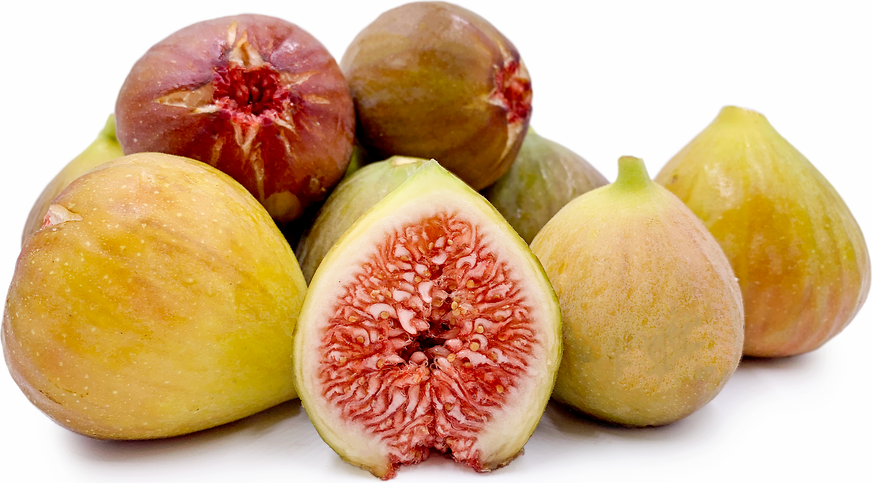


Houraishi Figs
Estimated Inventory, lb : 0
Description/Taste
Houraishi figs are slightly smaller than other fig varieties, averaging 3 to 8 centimeters in length, and have a tapered, tear-drop shape with a bulbous, round base. The semi-thick skin is firm and smooth, overlaid with small white lenticels, and ranges in color from yellow-green, red-brown, to dark purple-red. As the fig ripens, the eye at the base of the fruit, also known as an ostiole, will open, creating a small cross-like star shape, further widening with maturity. Underneath the skin, the flesh is comprised of tiny drupelets encased in a pulpy tissue, and the drupelets bear variegated hues of red and white. The flesh has a soft and sticky consistency and contains many tiny, edible seeds, contributing a subtle crunch. Houraishi figs have a unique soft and chewy texture and a honeyed, sweet taste combined with a balanced touch of acidity, varying in tartness depending on the fruit’s maturity.
Seasons/Availability
Houraishi figs are available in the fall.
Current Facts
Houraishi figs, botanically classified as Ficus carica, are the fruits of a wide-spreading, large-leafed tree belonging to the Moraceae or mulberry family. The soft fruits are a rare variety, highly favored for their balanced sweet flavor, and are one of the top fig cultivars produced in Japan. Houraishi figs are not native to Japan, but they have been so extensively cultivated for centuries that select distributors market them as a native species. The variety is also known as Horaishi, Horai, Hourai, Penglai, and the Taki fig. Houraishi figs are not produced commercially on a large scale due to their delicate nature. The figs are easily damaged in the shipping process, and the eye at the base of the fruit often secretes a sticky juice when ripe, causing other fruits in the shipment to be compromised. In the modern-day, Houraishi figs are often grown in home gardens as a specialty fruit. They are also a popular variety at “all you can pick” farms, as visitors will drive long distances across Japan to experience harvesting and consuming the unique, sweet fruit.
Nutritional Value
Houraishi figs are an excellent source of fiber to regulate the digestive tract, potassium to balance fluid levels within the body, and calcium to protect bones and teeth. Figs are also a good source of vitamin C to strengthen the immune system, vitamin A to maintain healthy organ functioning, and other nutrients, including iron, magnesium, phosphorus, and vitamin K. Houraishi figs were used during the Edo period in Japan as a natural, medicinal ingredient, believing the fruits could help regulate the intestines and encourage digestion when consumed. The leaves were also used to help reduce irritation on the skin and were boiled into tea to soothe the throat.
Applications
Houraishi figs have a sweet and subtly tart flavor primarily consumed fresh, out-of-hand to savor the fruit’s delicate, chewy, soft nature. The figs can be peeled or sliced in half, and the flesh can be scooped out with a spoon, eaten by itself, or spread onto bread, cheese, or crackers. The skin is edible, but many prefer not to eat it due to its fibrous, tough texture. Houraishi figs can also be tossed into salads, fried into tempura, frozen and blended into sorbets, dried for extended use, or cooked into jams, jellies, and sauces to pour over bread, grilled meats, and tarts. In Japan, figs are popularly used in ichijiku daifuku, a rice cake stuffed with the fruit, or used in a compote known as ichijiku no kanroni, topped over loaf cakes. Houraishi figs pair well with meats such as prosciutto, bacon, ham, pork, or duck, herbs including thyme and rosemary, fennel, chicory, almonds, walnuts, cheeses such as brie, blue, and goat, and spices including cardamom and cinnamon. Whole, unwashed Houraishi figs will keep 2 to 3 days when wrapped in plastic or stored in a sealed container in the refrigerator.
Ethnic/Cultural Info
The name Houraishi is believed to be derived from a mountain on a mythical island known as Hourai or Horai, found in Japanese mythology. The mythical land is also present in Chinese mythology under the name Penglai. Legend has it that immortal beings inhabit Hourai, and it is one of three sacred islands in the East China Sea. The mountain is specifically home to eight immortals who reside in palaces embellished with jewels, platinum, and gold, and there is also an immortal Chinese wizard known as Anqi Sheng. Though many have tried, the three sacred islands have never been discovered, and the eight immortals hold the secrets to life, controlling good and evil. Figs are also known as the “fruit of longevity” in Japan, acquiring this name due to their high nutritional content, promoting anti-aging, and preventing skin damage.
Geography/History
Houraishi figs are native to China and were introduced to Nagasaki, Japan, over four hundred years ago. Historians believe the fruits were brought to Japan by Portuguese sailors traveling from Penglai, China, sometime in the 17th century. Houraishi figs were spread along the coastal regions of Japan and were widely planted in the Fukuoka Prefecture on the island of Kyushu, where the climate was suitable for growing the fruit. In addition to the fruits, the fig trees were planted as an ornamental variety in home gardens, appreciated for their large leaves. Today Houraishi figs are predominately grown in the Hiroshima prefecture and in Izumo city, which is a part of the Shimane Prefecture along the western coast of Japan. The figs can also be found at select farms in Onomichi city, Ogaki city, and throughout the Fukuoka Prefecture. Outside of Japan, the figs are cultivated on a small scale in Thailand, China, and Malaysia.
Recipe Ideas
Recipes that include Houraishi Figs. One
| Savor the Harvest |
|
Caramelized Onion and Gorgonzola Fig Tart |
| The Door into Promised Lands |
|
Japanese Horaishi Fig Compote |
| Nugget Markets |
|
Fig & Chèvre Canapés |




